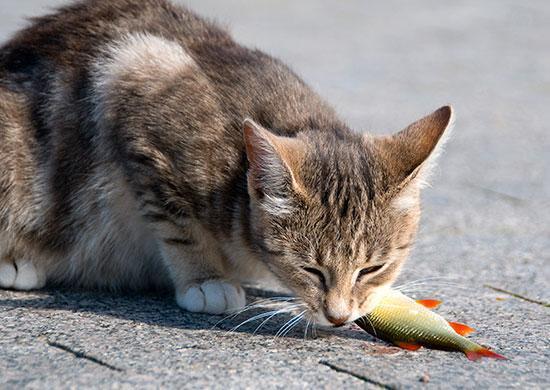This content is archived from the Feline Nutrition Foundation
Answers: Kitty That Only Wants Fish
- Updated: Saturday, June 01, 2019 02:48 PM
- Published: Saturday, July 26, 2014 08:16 PM
- Written by Lyn Thomson, BVSc DipHom
 My cat only wants to eat fish! Can I feed her a diet that is mostly fish or should I try to limit how often I feed it?
My cat only wants to eat fish! Can I feed her a diet that is mostly fish or should I try to limit how often I feed it?
Fish contains thiaminase, an enzyme that destroys thiamine, which is vitamin B1. Thiamine deficiency causes severe neurological symptoms that can be fatal. As obligate carnivores, cats have a high requirement for B vitamins – a continual dietary source is required to prevent deficiency. It is rare in cats consuming their natural prey-based diet, as B vitamins are plentiful in animal tissues. A cat would have to eat fish at every meal for a long time to develop a deficiency. I recommend cats consume fish up to three times a week. Variety is the key when feeding a raw cat food diet. I would encourage the feeding of any particular food up to three times a week, but no more.
Be careful if feeding meat-only products – including fish or shellfish – that use a sulphur-based preservative. These preservatives inhibit thiamine absorption. They "hold" the colour of the meat for an unnaturally long time so they stay looking good in the fridge. The preservatives can also trigger asthma in cats.¹ Products marketed for pets, e.g. commercial fresh "pet meat," "pet mince" or processed/manufactured "pet food rolls," may contain sulphite preservatives, so check the labels carefully. Thiamine deficiency can readily occur when cats are fed a diet containing sulphite preservatives.²
The essential fatty acids in oily fish are beneficial for cats, particularly those with chronic inflammatory health issues. It is a good idea to include oily fish in raw food for cats, up to 2-3 times per week. Tinned tuna is not the best source, so try sardines canned in water instead. They are less likely to pose a heavy metal risk than predatory fish such as tuna.
Additional Reading
The Case Against Cod Liver Oil
Answers: Flaxseed Oil for Kitty?
If you are feeding fresh-caught fish, you should freeze it to an internal temperature of -20°C (-4°F) for at least seven days to kill any parasites that may be present. Home freezers are usually between -17°C and -12°C (0°F and 10°F), and may not be cold enough. Commercially-caught fish are almost always frozen during transport, with processing to temperatures low enough to kill any parasites present.
Note: Feline Nutrition provides feline health and nutrition information as a public service. Diagnosis and treatment of specific conditions should always be in consultation with your own veterinarian. Feline Nutrition disclaims all warranties and liability related to the veterinary advice and information provided on this site.
Dr. Lyn Thomson trained at the University of Bristol in England and is studying with the Australasian College of Nutritional and Environmental Medicine. A dedicated and experienced advocate of bio-appropriate nutrition, Lyn practices in Auckland, New Zealand. HerRaw Essentials stores have grown to seven retail locations, providing a variety of raw diet products for cats and dogs.
1. BJ Freedman, "Sulphur Dioxide in Foods and Beverages: Its Use as a Preservative and its Effect on Asthma," British Journal of Diseases of the Chest 74, no. 2, April 1980, 128-34.
2. R Malik and D Sibraa, "Thiamine Deficiency Due to Sulphur Dioxide Preservative in 'Pet Meat' – a Case of Déjà Vu," Australian Veterinary Journal 83, no. 7, July 2005, 408-11.




